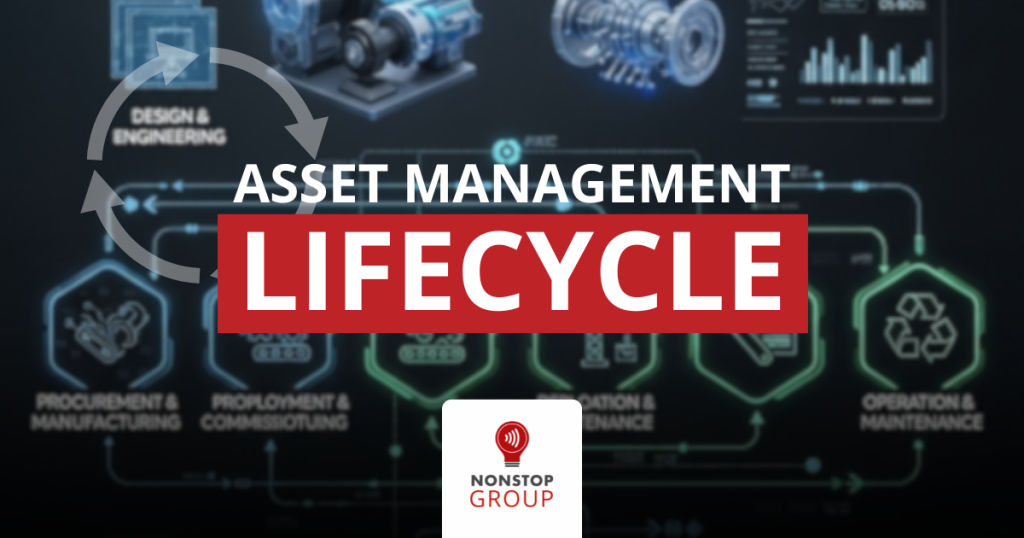6 Min Read

For manufacturing, energy, transportation, utilities, and construction sectors, the success of operations relies directly on the health and performance of their assets. Equipment, infrastructure, and machinery represent massive capital investments, and any failure or downtime can lead to significant financial losses, safety risks, and disruptions in productivity. This is where Asset Lifecycle Management (ALM) becomes indispensable.
ALM ensures that assets are tracked, maintained, and optimized across their entire lifespan, from acquisition to asset disposal. In industries where assets often operate around the clock, proactive monitoring and maintenance prevent costly breakdowns and extend the useful life of machinery. With IoT sensors and predictive analytics, companies can anticipate potential failures before they occur, minimizing unplanned downtime and avoiding expensive emergency repairs.
In this article, we’ll explore the five key stages of the Asset Management Lifecycle and how organizations can transform their asset management strategy into a competitive advantage. Let’s dig in!
What is the Asset Management Lifecycle?

Asset Lifecycle Management (ALM) is the process of ensuring that an organization’s assets perform effectively throughout their lifespan. It combines strategies aimed at maximizing efficiency, reducing costs, and extending asset life.
Assets can be both physical (infrastructure, equipment) and non-physical (capital, human resource). The asset lifecycle covers every stage: from asset acquisition and storage to use, maintenance, and eventual disposal. Effective management across these asset life cycle stages helps businesses achieve greater value and reliability from their assets.
Today, organizations increasingly rely on real-time monitoring tools, including IoT-enabled sensors, to track asset health and performance. This data allows businesses to perform preventive maintenance, minimizing unplanned downtime and avoiding costly repairs. Regular asset maintenance is a proactive approach to sustaining productivity and controlling operational expenses.
Asset life cycle management also generates valuable insights by tracking how assets perform over time within specific business contexts. These insights highlight how usage impacts asset condition, the asset’s contribution to productivity and revenue, and the costs tied to ongoing upkeep.
PRO TIP: Extend Asset Life with Predictive Maintenance
The NonStop Suite leverages IoT-enabled monitoring and AI-driven analytics to predict failures before they happen. Instead of relying on costly reactive fixes, maintenance teams receive automated alerts based on usage patterns, wear, and asset performance management metrics. This proactive approach minimizes downtime and prevents unexpected failures, lowers repair costs, and extends the useful life of your organization’s critical assets.
Smarter Asset Tracking With NFC Tags
Learn more about how NonStop Suite's NFC Asset Tracking Solution can help your Enterprise streamline operations to new heights.
Get A Free Product Tour
Why Is Asset Lifecycle Management Important For Asset-Heavy Industries?

Asset health is at the core of every business’s success. When significant capital is invested in acquiring assets, ensuring they operate at peak performance for as long as possible becomes essential. Asset Lifecycle Management (ALM) provides a structured, technology-driven approach to achieve this, enabling companies to scale operations, reduce risks, and maximize returns.
Modern ALM strategies uses IoT, AI, and analytics to automate maintenance tasks, deliver real-time visibility into asset conditions, and optimize decision-making. This helps businesses anticipate issues, prevent costly downtime, and cut unnecessary maintenance expenses. At the same time, ALM enhances collaboration across departments, aligning workflows and improving long-term planning. It also strengthens regulatory compliance with evolving regulations and safeguards assets against theft or data breaches through advanced asset tracking and security features.
Every new asset has a defined lifecycle, from acquisition and peak performance to eventual wear, repair, and replacement. With ALM, businesses can accurately forecast an asset’s useful life, track depreciation, and schedule preventive maintenance before failures occur. This data-driven approach not only extends the operational life of assets but also streamlines procurement decisions, replacement planning, and overall asset integration.
PRO TIP: Automate Compliance and Reporting
Manual compliance tracking can drain resources and lead to errors. With The NonStop Suite, all maintenance logs, inspections, and certifications are automatically recorded and easily retrievable. Customizable reporting tools ensure your organization stays audit-ready at all times, reducing risk while meeting industry regulations with confidence.
What are The 5 Stages of Asset Management Lifecycle?

ALM provides a structured methodology that enables businesses to extract maximum value from their assets while keeping costs and risk management under control. It creates a holistic cycle that enables businesses to align asset management practices with broader organizational objectives. When supported by modern digital tools and data-driven insights, asset management process transforms into a strategic advantage that drives efficiency, compliance, and long-term value creation.
Planning and Procurement
The first stage begins with identifying the asset needs of the organization and aligning them with strategic goals. A detailed budgeting process and cost-benefit analysis are carried out to ensure that the investment is financially justified. Vendor evaluation is also critical, as it helps in selecting reliable suppliers who can deliver quality products. Finally, purchase decisions are made with a focus on cost efficiency, durability, and long-term value.
Acquisition and Deployment
Once the procurement stage is complete, the next step involves receiving the assets, verifying their condition, and documenting them for record-keeping. Ownership is assigned, and assets are tagged for tracking and accountability. Initial setup and configuration are also performed to ensure that the assets are ready for operational use.
Operation and Utilization
In this stage, assets are integrated into daily operations. Effective monitoring, asset tracking, and location services ensure that resources are used optimally. User accountability and access control play a vital role in safeguarding the assets and maintaining efficiency. Proper asset utilization maximizes return on investment and enhances organizational productivity.
Maintenance and Optimization
Maintenance and optimization focus on keeping assets in peak condition. Preventive and predictive maintenance practices reduce the chances of unexpected breakdowns. Condition-based monitoring (CBM) helps track performance in real time, minimizing downtime. By implementing these measures, organizations can extend asset lifespan while optimizing performance.
Retirement and Disposal
In the final stage of the lifecycle, assets that are no longer functional or cost-effective are decommissioned. Depending on their condition, they may be recycled, resold, or disposed of in compliance with environmental regulations. Data wiping and proper disposal practices are essential to protect sensitive information and ensure sustainability.
PRO TIP: Data-Driven Decisions with Lifecycle Analytics
The NonStop Suite goes beyond tracking; it transforms raw data into actionable insights. Maintenance managers can visualize asset health, maintenance trends, and cost breakdowns at every stage of the lifecycle. With this 360° perspective, decision-makers can drive continuous improvements and maximize asset ROI.
Best Practices for Managing the Asset Lifecycle

Managing the asset lifecycle is essential for organizations that want to maximize the value of their investments, reduce operational costs, and improve long-term performance. A well-structured lifecycle management strategy provides visibility, control, and insights that guide better decision-making. The following best practices can help organizations manage assets more effectively.
Standardized Policies and Documentation
A strong asset management system begins with well-defined policies and thorough documentation. Standardized procedures for acquisition, usage, maintenance, and retirement create consistency across the organization. Documentation not only improves accountability but also ensures compliance with regulations and reduces the risk of mismanagement or duplication of effort.
Asset Classification and Tagging
Clear asset classification and tagging systems provide visibility into the asset base. Assigning barcodes, RFID tags, or digital identifiers allows organizations to track assets efficiently, monitor their movement, and reduce the likelihood of misplacement. Categorizing assets by type, criticality, or function also simplifies reporting, budgeting, and decision-making.
Lifecycle Tracking Templates
Using structured templates for lifecycle tracking ensures that data is captured at every stage, from purchase and deployment to maintenance and disposal. Templates standardize record-keeping, making it easier to identify patterns such as recurring failures or rising maintenance costs. This information supports timely decisions about repair, replacement, or upgrades.
Integration with Technology Tools
Modern technology plays a critical role in effective asset lifecycle management. Computerized Maintenance Management Systems (CMMS), Enterprise Asset Management (EAM) platforms, and IoT-enabled solutions streamline workflows and automate data collection. These systems provide real-time updates, enabling organizations to shift from reactive to proactive asset maintenance management.
Real-Time Data and Analytics
The use of real-time data and analytics strengthens forecasting and planning. Insights into asset health and performance allow organizations to minimize downtime, extend useful life, and allocate resources more efficiently. Predictive analytics further enhances decision-making by identifying risks before they lead to failures.
Performance Measurement and KPIs
Key Performance Indicators (KPIs) provide measurable insights into asset effectiveness. Metrics such as Mean Time Between Failures (MTBF), facility maintenance costs relative to asset value, and downtime rates highlight areas for improvement. Regular monitoring ensures that asset strategies remain aligned with organizational goals.
PRO TIP: Boost Team Efficiency with Mobile Access
The NonStop Suite’s mobile-friendly platform empowers field teams to access asset data, update work orders, and log maintenance activities directly from the site. No more delays or duplicate entries; with this asset management software, everyone stays connected in real time, enhancing coordination and speeding up task completion.
Conclusion: Future-Proof Your Organization with an Optimized Asset Management Lifecycle
For industries where assets drive revenue, ALM is not an operational necessity but a strategic advantage. It protects capital investments, enhances asset reliability, improves productivity, and supports long-term profitability by keeping critical assets performing at their best.
The NonStop Suite by The NonStop Group takes asset lifecycle management to the next level. With smart features like Dynamic eForms for accurate data handling, Smart NFC technology for asset identification, automated scheduling to streamline maintenance workflows, and performance tracking, organizations can unlock complete visibility and control every stage of the asset lifecycle. By integrating with the existing systems, The NonStop Suite ensures seamless adoption while delivering actionable insights that reduce downtime, cut costs, and extend asset lifespan.
Should your organization want to transform your asset management life cycle into a competitive edge, consult The NonStop Group today to book a FREE personalized product tour and see how The NonStop Suite can optimize your organization’s asset management strategy.

